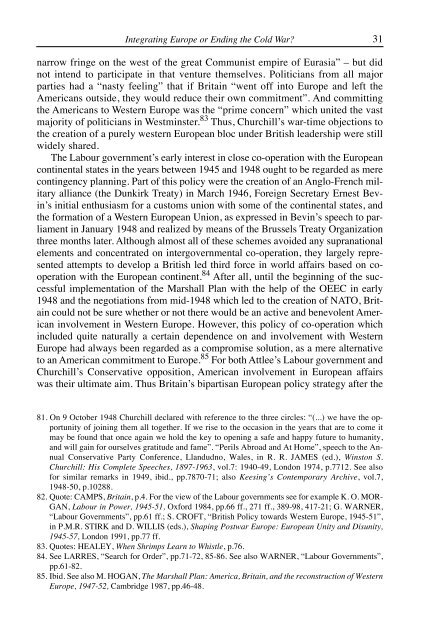journal of european integration history revue d'histoire de l ...
journal of european integration history revue d'histoire de l ...
journal of european integration history revue d'histoire de l ...
You also want an ePaper? Increase the reach of your titles
YUMPU automatically turns print PDFs into web optimized ePapers that Google loves.
Integrating Europe or Ending the Cold War? 31<br />
narrow fringe on the west <strong>of</strong> the great Communist empire <strong>of</strong> Eurasia” – but did<br />
not intend to participate in that venture themselves. Politicians from all major<br />
parties had a “nasty feeling” that if Britain “went <strong>of</strong>f into Europe and left the<br />
Americans outsi<strong>de</strong>, they would reduce their own commitment”. And committing<br />
the Americans to Western Europe was the “prime concern” which united the vast<br />
majority <strong>of</strong> politicians in Westminster. 83 Thus, Churchill’s war-time objections to<br />
the creation <strong>of</strong> a purely western European bloc un<strong>de</strong>r British lea<strong>de</strong>rship were still<br />
wi<strong>de</strong>ly shared.<br />
The Labour government’s early interest in close co-operation with the European<br />
continental states in the years between 1945 and 1948 ought to be regar<strong>de</strong>d as mere<br />
contingency planning. Part <strong>of</strong> this policy were the creation <strong>of</strong> an Anglo-French military<br />
alliance (the Dunkirk Treaty) in March 1946, Foreign Secretary Ernest Bevin’s<br />
initial enthusiasm for a customs union with some <strong>of</strong> the continental states, and<br />
the formation <strong>of</strong> a Western European Union, as expressed in Bevin’s speech to parliament<br />
in January 1948 and realized by means <strong>of</strong> the Brussels Treaty Organization<br />
three months later. Although almost all <strong>of</strong> these schemes avoi<strong>de</strong>d any supranational<br />
elements and concentrated on intergovernmental co-operation, they largely represented<br />
attempts to <strong>de</strong>velop a British led third force in world affairs based on cooperation<br />
with the European continent. 84 After all, until the beginning <strong>of</strong> the successful<br />
implementation <strong>of</strong> the Marshall Plan with the help <strong>of</strong> the OEEC in early<br />
1948 and the negotiations from mid-1948 which led to the creation <strong>of</strong> NATO, Britain<br />
could not be sure whether or not there would be an active and benevolent American<br />
involvement in Western Europe. However, this policy <strong>of</strong> co-operation which<br />
inclu<strong>de</strong>d quite naturally a certain <strong>de</strong>pen<strong>de</strong>nce on and involvement with Western<br />
Europe had always been regar<strong>de</strong>d as a compromise solution, as a mere alternative<br />
to an American commitment to Europe. 85 For both Attlee’s Labour government and<br />
Churchill’s Conservative opposition, American involvement in European affairs<br />
was their ultimate aim. Thus Britain’s bipartisan European policy strategy after the<br />
81. On 9 October 1948 Churchill <strong>de</strong>clared with reference to the three circles: “(...) we have the opportunity<br />
<strong>of</strong> joining them all together. If we rise to the occasion in the years that are to come it<br />
may be found that once again we hold the key to opening a safe and happy future to humanity,<br />
and will gain for ourselves gratitu<strong>de</strong> and fame”. “Perils Abroad and At Home”, speech to the Annual<br />
Conservative Party Conference, Llandudno, Wales, in R. R. JAMES (ed.), Winston S.<br />
Churchill: His Complete Speeches, 1897-1963, vol.7: 1940-49, London 1974, p.7712. See also<br />
for similar remarks in 1949, ibid., pp.7870-71; also Keesing’s Contemporary Archive, vol.7,<br />
1948-50, p.10288.<br />
82. Quote: CAMPS, Britain, p.4. For the view <strong>of</strong> the Labour governments see for example K. O. MOR-<br />
GAN, Labour in Power, 1945-51, Oxford 1984, pp.66 ff., 271 ff., 389-98, 417-21; G. WARNER,<br />
“Labour Governments”, pp.61 ff.; S. CROFT, “British Policy towards Western Europe, 1945-51”,<br />
in P.M.R. STIRK and D. WILLIS (eds.), Shaping Postwar Europe: European Unity and Disunity,<br />
1945-57, London 1991, pp.77 ff.<br />
83. Quotes: HEALEY, When Shrimps Learn to Whistle, p.76.<br />
84. See LARRES, “Search for Or<strong>de</strong>r”, pp.71-72, 85-86. See also WARNER, “Labour Governments”,<br />
pp.61-82.<br />
85. Ibid. See also M. HOGAN, The Marshall Plan: America, Britain, and the reconstruction <strong>of</strong> Western<br />
Europe, 1947-52, Cambridge 1987, pp.46-48.

















